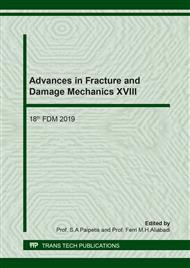p.55
p.61
p.67
p.73
p.79
p.85
p.92
p.98
p.104
Fracture Surface of a Ti-6Al-4V Specimen with EDM Notches Tested under Quasi-Static Loading in Methanol
Abstract:
Ti-6Al-4V titanium alloy is a high strength-to-mass ratio material common in a lot of engineering fields. Its surface oxide can guarantee the protection of the substrate from various corrosive media. Unluckily, this film can be scratched in presence of mechanical and chemical loads and for this reason the corrosion resistance can decrease. The Structural Mechanics Laboratory (SM-Lab) is carrying out a characterization of the alloy in different environments under quasi-static loading. In this paper, a summary of the outcomes of the investigation and the description of the fracture surface of a specimen with EDM notches quasi-statically tested in methanol is provided
Info:
Periodical:
Pages:
79-84
Citation:
Online since:
December 2019
Keywords:
Price:
Сopyright:
© 2020 Trans Tech Publications Ltd. All Rights Reserved
Share:
Citation:


